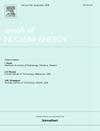Development of a thermal–hydraulic system code with multi-dimensional modeling for liquid metal pool-type fast reactor and preliminary verification and validation
IF 1.9
3区 工程技术
Q1 NUCLEAR SCIENCE & TECHNOLOGY
引用次数: 0
Abstract
Liquid-metal pool-type fast reactors exhibit unique transient and steady-state behaviors under operational and accidental conditions due to their complex three-dimensional geometries and flow transport properties. To accurately capture these properties, a system analysis code LIMSAC integrating three-dimensional complex spatial and sub-channel hydrodynamic components, is developed in this paper. The code employs the Jacobi-Free-Newton-Krylov (JFNK) method for solving the field equations and demonstrates excellent robustness in dealing with nonlinear and complex coupled phenomena in multi-physics field problems. The development of the code includes the construction of the governing equations and component models, the numerical discretization scheme and a detailed overview of the solution method. The code’s architecture and modules have been developed and validated through numerical tests and experimental data, showing the ability to accurately simulate the thermal–hydraulic characteristics of liquid metal reactor systems, including transient variations in natural circulation loops and thermal stratification in liquid metal pools. The validation results show that the code is capable of simulating the thermal–hydraulic characteristics of the liquid metal reactor system accurately, including the transient variations of the natural circulation loop and the thermal stratification phenomenon of the liquid metal pool. The simulation results are consistent with experimental data in general, demonstrating the accuracy and reliability of the code. Future work will focus on further analytical and experimental studies to develop multi-dimensional turbulence models, extend the code framework, and add component models to accommodate a wider range of engineering safety analysis needs.
开发液态金属池式快堆多维建模热液系统代码并进行初步验证和确认
液态金属池型快堆由于其复杂的三维几何形状和流动输运特性,在运行和事故条件下表现出独特的瞬态和稳态行为。为了准确地捕捉这些特性,本文开发了一个集成三维复杂空间和子通道水动力分量的系统分析程序LIMSAC。该程序采用Jacobi-Free-Newton-Krylov (JFNK)方法求解场方程,在处理多物理场问题中的非线性和复杂耦合现象方面表现出良好的鲁棒性。代码的开发包括控制方程和组件模型的构建、数值离散化方案和求解方法的详细概述。该代码的架构和模块已经通过数值测试和实验数据进行了开发和验证,显示了精确模拟液态金属反应堆系统热水力特性的能力,包括自然循环回路的瞬态变化和液态金属池的热分层。验证结果表明,该程序能够较准确地模拟金属液堆系统的热水力特性,包括自然循环回路的瞬态变化和金属液池的热分层现象。仿真结果与实验数据基本一致,验证了代码的准确性和可靠性。未来的工作将集中于进一步的分析和实验研究,以开发多维湍流模型,扩展代码框架,并添加组件模型,以适应更广泛的工程安全分析需求。
本文章由计算机程序翻译,如有差异,请以英文原文为准。
求助全文
约1分钟内获得全文
求助全文
来源期刊

Annals of Nuclear Energy
工程技术-核科学技术
CiteScore
4.30
自引率
21.10%
发文量
632
审稿时长
7.3 months
期刊介绍:
Annals of Nuclear Energy provides an international medium for the communication of original research, ideas and developments in all areas of the field of nuclear energy science and technology. Its scope embraces nuclear fuel reserves, fuel cycles and cost, materials, processing, system and component technology (fission only), design and optimization, direct conversion of nuclear energy sources, environmental control, reactor physics, heat transfer and fluid dynamics, structural analysis, fuel management, future developments, nuclear fuel and safety, nuclear aerosol, neutron physics, computer technology (both software and hardware), risk assessment, radioactive waste disposal and reactor thermal hydraulics. Papers submitted to Annals need to demonstrate a clear link to nuclear power generation/nuclear engineering. Papers which deal with pure nuclear physics, pure health physics, imaging, or attenuation and shielding properties of concretes and various geological materials are not within the scope of the journal. Also, papers that deal with policy or economics are not within the scope of the journal.
 求助内容:
求助内容: 应助结果提醒方式:
应助结果提醒方式:


